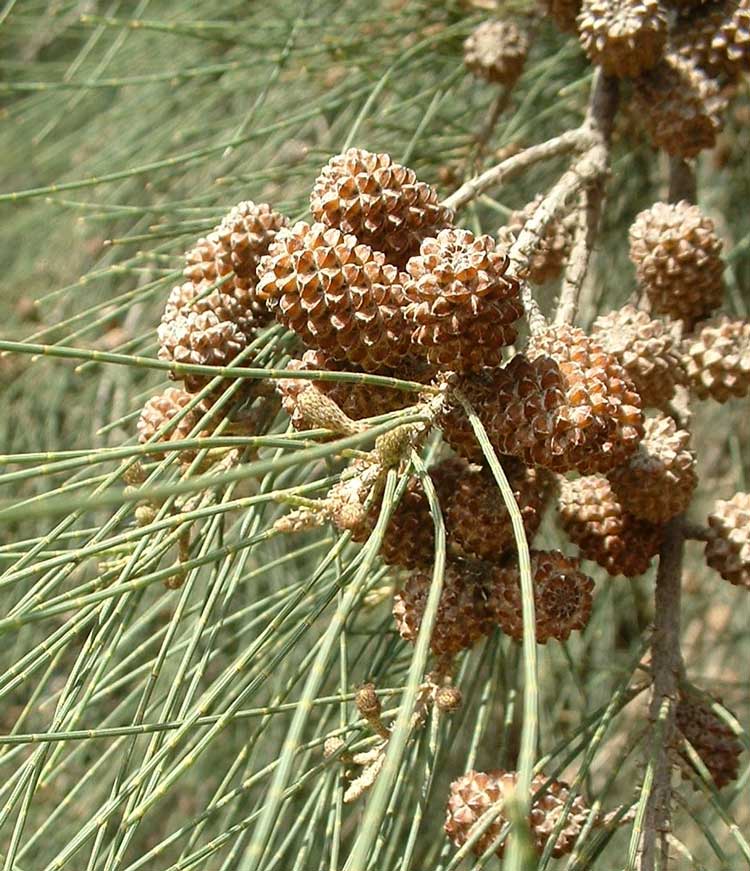
Casuarina cunninghamiana (*)
Classification System: APG IV
Superregnum: Eukaryota
Regnum: Plantae
Cladus: Angiosperms
Cladus: Eudicots
Cladus: Core eudicots
Cladus: Rosids
Cladus: Eurosids I
Ordo: Fagales
Familia: Casuarinaceae
Genus: Casuarina
Species: Casuarina cunninghamiana
Subspecies: C. c. subsp. cunninghamiana – C. c. subsp. miodon
Name
Casuarina cunninghamiana Miq., 1848
References
Primary references
Miquel, F.A.W. 1848. Nieuwe Verh. Eerste Kl. Kon. Ned. Inst. Wetensch. Amsterdam, ser. 2, 13: 56
Links
Govaerts, R. et al. 2019. Casuarina cunninghamiana in World Checklist of Selected Plant Families. The Board of Trustees of the Royal Botanic Gardens, Kew. Published on the internet. Accessed: 2019 Sep 29. Reference page.
International Plant Names Index. 2019. Casuarina cunninghamiana. Published online. Accessed: Sep 29 2019.
Tropicos.org 2019. Casuarina cunninghamiana. Missouri Botanical Garden. Published on the internet. Accessed: 2019 Sep 29.
USDA, ARS, Germplasm Resources Information Network. Casuarina cunninghamiana in the Germplasm Resources Information Network (GRIN), U.S. Department of Agriculture Agricultural Research Service. Accessed: 07-Oct-06.
Vernacular names
English: River sheoak
日本語: カニンガムモクマオウ
Casuarina cunninghamiana, commonly known as river oak or river she-oak,[3] is a she-oak species of the genus Casuarina. The native range in Australia extends from Daly River in the Northern Territory, north and east in Queensland and eastern New South Wales.[4][5]
Description
Male flowers of a C. cunninghamiana subsp. cunninghamiana.
Immature seedpods in situ
The River Oak is an evergreen tree with fine greyish green needle-like foliage that grows to a height of 10–35 m (33–115 ft) with a spread of about 10 metres (33 ft).[4][6] The trunk is usually erect, with dense rough bark. Flowers are reddish-brown in the male and red in the female.[4] Cones are small, nearly round to elongated and about 10 millimetres (0.39 in) across.[4]
Habitat
Trees are usually found in sunny locations along stream banks and swampy areas.[4] It's widely recognised as an important tree for stabilising riverbanks and for soil erosion prevention accepting wet and dry soils. The foliage is quite palatable to stock.[5] C. cunninghamiana is frost tolerant down to around −8 °C (18 °F) and is widely used effectively as a screening plant. It is useful on windy sites and is also suited to coastal areas. C. cunninghamiana has been introduced into several other countries for the purpose of agroforestry.[6]
Subspecies
There are two subspecies:
C. cunninghamiana subsp. cunninghamiana. Large tree to 35 m (115 ft) tall. Eastern New South Wales, north and east Queensland.[4][6]
C. cunninghamiana subsp. miodon. Small tree to 12 m (39 ft) tall. Daly River and Arnhem Land in the Northern Territory and the Gulf of Carpentaria in Queensland.[4][6]
The species has many common names including River Oak, River She-oak or Creek Oak.[5]
Invasive species
Casuarina cunninghamiana is an invasive species in the Everglades in Florida[7] and in South Africa.[8]
References
"Casuarina cunninghamiana". Australian Plant Name Index, IBIS database. Centre for Plant Biodiversity Research, Australian Government.
Miquel, F.A.W. (1848) Revisio critica Casuarinarum: 56, t. VI A
Casuarina cunninghamiana Miq.
Boxshall, Ben; Jenkyn, Tim. "River she-oak" (PDF). Department of Primary Industries. Victorian Government. Archived from the original (PDF) on 15 September 2009. Retrieved 23 April 2011.
Boland, D. J.; Brooker, M. I. H.; Chippendale, G. M.; McDonald, M. W. (2006). Forest trees of Australia (5th ed.). Collingwood, Vic.: CSIRO Publishing. p. 80. ISBN 0-643-06969-0.
"Casuarina cunninghamiana". Florabank. Retrieved 23 April 2011.
"Biological control of Australian native Casuarina species in the USA". Commonwealth Scientific and Industrial Research Organisation. 16 May 2007. Archived from the original on 5 June 2011. Retrieved 16 September 2010.
"SANBI:Declared Weeds & Invader Plants". South African National Biodiversity Institute. Archived from the original on 6 October 2014. Retrieved 25 September 2014.
Retrieved from "http://en.wikipedia.org/"
All text is available under the terms of the GNU Free Documentation License

